万字长文,从好莱坞的剧本创作视角探索游戏关卡设定
作者:Babak Kaveh
在过去四十年上映的几乎所有好莱坞电影都是从单一结构的剧本改编而来的。本文将介绍好莱坞电影的结构,将考察将这种结构运用于游戏玩法设计的可能性。不过,我们不是在 游戏的故事中采用剧本结构,而是只用游戏的机制创造剧情,更准确地说,将这种结构和游戏阶段运用于不同的游戏类型。
在大部分的好莱坞影中,首先,观众会看到电影的主角和他所在的场景。然后,发生了一件改变当前局面的事件,观众开始对主角有所了解。在这里,主角面临第一个挑战,他要 靠这个挑战让观众认识自己。在电影的中间部分,观众得知主角必须做出什么关键决定、他的最终目标是什么——这是他无法脱身的处境。再然后,主角经历了一次战斗,这场战 斗会以致命一击结束,如果主角能克服这最后一个挑战,那么观众就会看到他的人生以及别人的人生因此而改变——他们得到奖励。如果电影有续集,那么观众就会隐隐看到另一 个挑战的暗示。当然,这种结构还有其他变体,比如主角不是一个人,而是一群人,敌人可能不是人类,而是一种自然力量或主角必须克服的某种恐惧。
令人惊讶的是,我们很容易就能想出另一种剧情结构,但是几乎没有剧本在跳出这种相当严密的结构之后还能获是成功,至少好莱坞电影是这样的;这是一种必胜的结构,电影制 作人都知道。那么,这对作为游戏设计师的我们有何启发?很多:这个结构告诉你如何将游戏关卡变成包含玩家在内的剧情——你的玩家喜欢并记得怎么玩的小电影,这种玩法剧 情会与绝大多数玩家产生共鸣,不过这取决于他们对这个小电影的理解和认同程度。
我知道,在这样一个大环境之下——设计师们仍然认为故事是多余的,是罪恶的,声称给予玩法剧情结构似乎是浪费时间,但请相信我,当我将好莱坞式配方运用到各种游戏关卡 设计时,你会发现它不仅让关卡更具连贯性,而且确实是头脑风暴时的绝好创意来源。在文章的另一个部分我将解释在《军团要塞2》(游戏邦注:以下简称《TF2》)中的一些最 成功的关卡如何运用这种结构,并据此为《TF2》设计一个新关卡。

Battleship_Movie(from mediamikes.com)
一部好莱坞电影的结构分解
以下是Michael Hauge对一部好莱坞电影《超级战舰》的结构描述和取自这部电影的截图。

The-Setup(from gamedesignideas)
图1、主角是一位冲动、散漫、好色的家伙
阶段1:开头
这是电影的开头部分,观众将看到主角(们),可能还有他的同伴。这是你要观众对主角(们)产生好印象的阶段。开头一般占电影总长度的10%。

The-Opportunity(from gamedesignideas)
图2、在主角被警察抓住后,主角的哥哥劝说他加入海军部队,希望他能好好生活
转折点1——机遇(10%)
在这里,主角面临新机遇或他无法抗拒/逃避的威胁(内在原因或外界压力)。这个机遇使主角脱离现状,踏上旅程,尽管按照逻辑,此时主角也可能回归现状,但我们知道这种事 是不会发生的。

The-New-Situation(from gamedesignideas)
图3、主角成了一名海军军官,并且恋爱了——仍然散漫,但过上了新生活
阶段2——新局面
在响应机遇或第一次威胁后,主角现在已经适应了新生活(如果他接受这种新生活的话)。此时,主角第一次意识到自己的敌人的存在,或者第一次学会如何使用枪。这是主角的 初期发现阶段,将引导他制定一个计划,以便达成机遇提出的目标,但在背景故事中,我们希望让观众知道冲突或矛盾以一个女人为中心。这个阶段占电影总长度的15%。

Change-of-Plans(from gamedesignideas)
图4、当外星人入侵地球时,“泡妞”就成浮云了!
转折点2——计划改变(25%)
在这里,主角不得不改变他的计划。计划的改变导致主角进入新的人生阶段,他也正是在这个时候明确了他要达到的最后一个可见目标。主角可能已经找到他心目中的“女神”并 且现在想和她永远在一起,或者也许之前出现的人想保护他得杀掉的人。所谓可见目标就是“观众支持主角在电影结局中必须达到的目标”。

progress(from gamedesignideas)
图5、人类舰队对战外星战舰
阶段3——发展
现在,主角处在最激烈的时刻,开始朝着可见目标前进。此时,主角开始从计划改变导致的措手不及状态中走出。在这个阶段,冲突矛盾仍然存在,但已经不能对主角构成威胁。 这部分占电影总长度的25%。

point-of-no-return(from gamedesignideas)
图6、主角的哥哥被外星人杀害了,他的船也毁了。没有回头路了,必须打败外星人(这是电影的可见目标)
转折点3——不归路(50%)
此时发生了一件事,或者一个情况导致主角无法回头继续执行他的计划。这个事件或时刻决定了主角从现在到电影结束的走向。桥被摧毁了,观众知道主角已经走上不归路。

Complications(from gamedesignideas)
图7、与外星人的“亲密接触”,但主角在与之近战中时时处于被动防守状态
阶段4——混乱
在这个阶段,斗争已经到了主角只能胜利不能失败的时刻。战斗成了一切。主角打得很辛苦,但就在主角似乎要得胜之际,事态又急转直下。这个阶段占电影总长度的25%。

the-Major-Setback(from gamedesignideas)
图8、外星人将主角的船撕成碎片
转折点4——大挫折(75%)
这是导致主角似乎完全无法达成目标的大灾难。他被抓获,或者重要的战友或同伴离开他或死亡或出卖他。此时,前途似乎一片黑暗。

the-final-push(from gamedesignideas)
图9、幸存者们重新集合,为最后一战作准备
阶段5——最后一战
现在主角已经获得战胜困难所需的所有能量和资源。他的人生之旅已经接近终点了——此时的前进步伐飞快。这个终点就是一切。这个阶段应该占电影总长度的15%-24%。

the-climax(from gamedesignideas)
图10、尽管上了年纪,主角的船仍然英勇无畏地战斗着,外星人的母舰被摧毁了,他们的阴谋被挫败了
转折点5——高潮(90%~99%)
这是主角面临最后的挑战的时候,决定了他自己的命运,并且可见目标已经达成了。在这里,主角战胜或杀死最终BOSS或解决了最后的罪恶之谜或舍身取义。这可能是观众之后记 忆最深刻的部分。

the-aftermath(from gamedesignideas)
图11、主角得到勋章或主角得到女孩,主角受到舰队司令的赏识和尊重——剧终
阶段6——余波
在这里,观众平静下来审视电影高潮的结局。主角结婚了或者下葬了或者从此过上幸福的生活了!这个阶段只占电影总长度的极小一部分,一般就几分钟。
好莱坞电影结构在游戏关卡设计中的运用
根据上文的分析,我们可以绘制出下图。其中,纵轴表示《超级战舰》的主角面临的挑战难度,横轴表示时间长度:
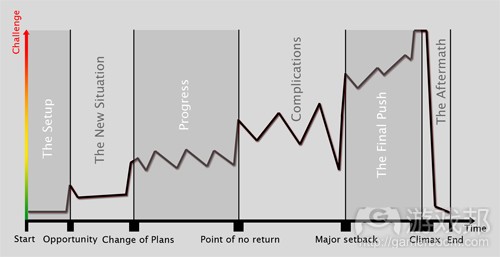
Challenge-vs-Time(from gamedesignideas)
这与多年前的许多游戏中的关卡非常相似:
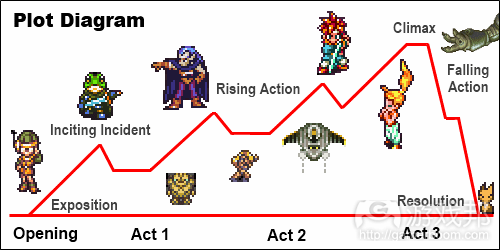
plot-diagram(from gamedesignideas)
现在我们来探讨一下如何将我们分析出来的这种成功的结构运用于关卡布置。
阶段1——开头
尽管许多设计师将这个阶段忽略不计,错误地认为电子游戏玩家希望直接跳到操作部分,但是,在关卡中加入一定长度的介绍有助于玩家确定自己的方向、了解角色、控制动作, 以及在战斗以前做出稳妥的决定。这是一个微妙的点,但如果你把玩家直接丢进战斗而不让玩家自己决定,玩家是不会感谢你的。现在,你可能会说,从玩家开始游戏的那一刻起 ,他们就已经做出迎接挑战的决定了,但不要忘了,允许玩家做选择始终是游戏的本质,玩家能做的有意义选择越多,关卡的效果就越好。
在关卡中添加开头是很容易的。平台游戏和射击类游戏的做法是在关卡的开始部分添加一段没有敌人的部分。《TF2》的做法是在大门开启以前,给玩家60秒的无敌时间和挑选级别 。而《辐射:新维加斯》则有一个完整的起始区域,没有敌人,只给玩家介绍背景故事。《魔兽世界》也类似,为每一个种族都提供一个安全区。设置“开头”区域有三个要点:
1、必须是安全的
2、必须告诉玩家游戏的环境和角色的背景故事
3、在游戏长度或关卡时间的前10%部分,玩家必须能够退出该区域
要点1和要点2是显而易见的,但我得解释一下要点3。以《辐射:新维加斯》为例。根据经验,我们推测游戏的关卡平均长度大约是1-2小时。这意味着玩家必须能够在游戏开始的 前6-12分钟内获得必要的资源。同样的,在《魔兽》中,玩家必须能够在他们呆在安全区的6-12分钟内获得有价值的技能。至于平台游戏,关卡可能只持续几分钟,所以第一个技 能或挑战应该在10秒内能使用。
当然,也有些游戏并不遵循这条原则,比如《BIT.TRIP Runner》就是一个典型。它有所失败是因为开始新关卡时非常容易让玩家感到压力和无助,需要几秒钟和几次成功跳跃才能 缓解那种消极情绪。并且,这款游戏不给玩家机会理解玩法元素及其作用,所以玩家第一次进入关卡时基本上坚持不到3秒钟就挂了。糟糕的《BIT.TRIP》!
转折点1——机遇(10%)
在这里,玩家遇到第一个挑战。这个挑战当然不是让玩家踏上拯救世界的旅程——那是之后的任务,而是让玩家脱离安全的环境,进入新领域或新情境,在那里玩家必须开始行动 ,并且积极地了解新选择。这也是大多数游戏没做好的地方。这些游戏急于向玩家介绍故事的意义和玩法挑战,过早地把拯救世界免于核武器危害的秘密任务交给主角。
跳过转折点直接把主角送上不归路,就使设计师损失了一个重要机会——揭露主角的内心世界和介绍他的战友(NPC),而这是塑造角色形象的关键。另外,这么做还导致玩家脱离 游戏剧情,没有充分的理由去关心游戏世界或NPC或其他等着他拯救的在线玩家。
创造转折点的方法很多,但共同点就是包含一个作用于玩家的事件,迫使玩家接受第一个挑战或呆在安全区。在《TF2》中,当大门第一次开启,玩家可以决定呆在基地的安全区或 等所有“无敌”状态都用完了以及第一次混战结束就出去。另一种方法是给玩家最好的武器或交通工具,让他们看到未来的自己是多么强大,根本没有失败的风险。当然,这种做 法有一定的危险,一旦玩家的美好幻想被一把生锈的小刀——游戏给的防身武器割裂,他们不免感到受挫。《Oblivion》就有一个漂亮的转折点,角色的身份从犯人变成保护国王 的战士,让玩家感到荣耀。
阶段2:新局面
在这个阶段,战士就开始战斗,间谍就开始暗算。注意,这时我们还没有让玩家开始为终极目标奋斗。如果终极目标是占领某个控制点,那么转折点是不会让玩家成功的。主角( 在《TF2》中是一支突击小队)这时候应该还没有机会获胜。比如,让一类职业难以逃脱最初的基地,或者单纯地让所有人开始真正的任务以前都要经历一番挣扎—-他们仍然要杀 死敌人,但他们就是达不到控制点—-目前还达不到。
转折点2——计划改变(25%)
经过第一场战斗,或新生活的开端,主角开始走上目标的奋斗之旅。在《TF2》中,这意味着突击小队开始推车,或向控制点前进。我们有选择地削弱敌人(《TF2》中的守卫)的 实力,即让守卫离开防御位置很长时间才回来,或延迟他们的刷出时间,或取消一些有利的防御位置,所以玩家在这个过程就不那么困难了。在MMO中,玩家在这个阶段会得到一个 强大的技能,使他们更快地完成任务的第一部分。在平台游戏中,此时玩家会得知主角的目标就是拯救公主,或第一次遇见到这个性感女郞。
阶段3——发展
主角在这个阶段过得比较轻松。游戏场所有利于主角,可以也应该有利于主角,甚至在玩家对抗玩家的游戏中也一样。在《TF2》中,突击小队在关卡的这个部分占据了大多数有利 位置。这可能是打开了第一个控制点的通道(后门),或开辟了一条导弹车能通过的、易于防守的道路。这个阶段应该占据游戏总长度或游戏持续时间的25%,这时的主角形象应该 是很高大的。
转折点3——不归路(50%)
与体育运动不同,好莱坞电影中的一半时间不是休息和放松——在这个时候会发生一件大事,足以摧毁主角回归原来的生活或甚至新生活的任何机会。也正是在这个时候,主角下 定决心他必须勇往直前了。
在关卡设计中,这意味着:
对于平台游戏:现在主角不动用新学会的双跳技能或刚得到的火箭就不能通过这个关卡;不使用必杀技就杀不了太多敌人。如果主角失败了或速度放缓了,公主就要被杀掉了—— 应该保证玩家知道这一点!
对于MMO/RPG:这时游戏世界将响应主角的行动而发生改变。比如,一条特殊的巨龙飞升而起,玩家要在它摧毁自己的故乡以前打败它。
对于多人射击游戏如《TF2》或《战地3》:这是进攻小队取得登录/刷出位置的控制权的时候,这个位置太好了,所以原来的基地被废弃了,或可能甚至是被关闭了。
阶段4——混乱
在阶段3,主角已经占尽好处。现在该是局势急转直下的时候了,此时主角与敌人势均力敌。这意味着双方与赛点的距离是相同的。例如,主角的小宇宙终于爆发了,因为敌人NPC 也到达这个水平了。
我们还可以人为地引入额外的挑战,如在地图上或剧情中增加额外的冲突—-可能主角得牺牲一名战友才能渡过难关,或者设置一个陷阱让主角的HP只剩一点点。出卖和时限也是常 用的故事元素。这是《TF2》关卡的一部分,敌人大开杀戒,耗竭了主角的瞬间传送精力、破坏了主角的防御阵形,这就导致了接下来的转折点。
转折点4——大挫折(75%)
这是主角有史以来最黑暗的一段时期。我们可以在这里对玩法/关卡元素稍作调整,不过这需要一定的程序工作才能生效。经过前一个阶段的所有混乱,我们希望主角处于非常脆弱 的状态,并且这种状态至少要持续一小段时间。以下方式可以达到这个目的:
对于RPG:最终BOSS出现,玩家进攻他时,他会对玩家施加许多负状态,直到BOSS退出战场。
对于平台游戏:玩家的生命药水/弹药会大大减少。现在主角得开始数自己的子弹和命值剩多少了。
对于策略游戏:玩家被敌人三面包围,或甚至更糟糕,战友死在前一个阶段后,主角现在的防御力减弱,得孤身承受严峻的考验。我们希望主角以一对多,孤身奋战到最后。
对于多人游戏:敌人所在地有强大的后卫或狙击手。这两道障碍大大打击了主角的士气,使玩家清楚地感觉到什么叫无法克服的困境。但是,我们应该保证这两队敌人是有办法打 败的。不要把主角置身于一个敌人可以非常容易反复攻击他的地方,否则就会在玩家真正达成目标以前就引发游戏高潮。
为了让高潮的效果达到最佳,我们必须让所有元素(游戏邦注:逼近目标、最后一战、大量冲突、实力相当的战斗)在同一时间汇合。
阶段5——最后一战
在阶段3,主角占尽所有好处;在阶段4,双方实力持平。现在轮到主角找敌人(在《TF2》中是守卫)算帐的时候了。此时敌人的狙击点方位好,隐蔽性强。在《TF2》中,因为目 的地更接近守卫的基地,所以敌人其实是占了上风。在其他游戏中,这时玩家会频繁地切换武器,因为弹药消耗得飞快;玩家还要使用大量药水,但几乎没有效果。最后一战是一场激烈的占山为王的战役(敌人所处的位置比玩家更高一些,有地势上的优势,所以称最后一战可以形象地比喻为“占山为王”)。
在这个阶段,主角必须明确目标(比如,最后一个控制点或《TF2》中的推车地图的最后个路径点)。他必须能够很快达到冲突的焦点(在《战地》中,在最后一个控制点以前必须 有各种速度快的交通工具),并且最后一战的战场必须非常集中。不要把最后一战安排在宽广开阔的区域或战壕。要让双方直接对抗。不要忘了给敌人大量优势,使他能够重创主 角。如果你的游戏机制允许时间限制,那就在这个阶段的末期用上吧。在这个关卡里,这是设计师可以尽情“虐”玩家的唯一环节;只要玩家最终能够战胜敌人,他们就不会有太 多抱怨(好吧,他们还是会报怨的,不过他们会体会到设计的“用心良苦”的。)
我已经指出一些可用于创造最后一击的元素,那么我们如何在不同的游戏类型中运用呢?
对于策略游戏:在主角独自战胜挫折以后,现在又团结到一切可以团结的力量了;而敌人的势力也已经遍布全球了。最后一战发生在一个沙漏关卡,一波又一波的敌人在集中区域 里不断侵蚀玩家一方的防御力量。随着高潮逼近,敌群的规模越来越大,玩家一方也随之加快杀敌速度。玩家在战斗的某一瞬间会觉得妥善管理自己的单位非常困难。如果玩家再 不摧毁敌人的核工厂,时间一到,核武器就要生产出来了。敌人越来越多,甚至出现了以前从来没见过的敌人类型。
对于平台游戏:玩家边跑,平台边下落……所以玩家必须快速向前跑,但敌人又很强悍……有时候玩家甚至会觉得与其冲上去杀掉敌人,不如小心地躲开敌人的子弹。只有一条行 得通的路,并且玩家也没空思考是否还有其他路。这个阶段没有谜题,只有激烈的战斗和向前冲。也许游戏世界就在你身后迅速崩塌,也许你会听到主角的“梦中情人”正在尖叫 ,因为她就要被大BOSS残害了。
对于RPG:玩家已经发现了最终BOSS所在的地下城,但他的小兵们也不好对付。一波接一波的敌人从四面逼近,且越来越难对付,玩家没有时间探索,甚至顾不上开宝箱。敌人刷新 得非常快,玩家没办法原路返回或就地休息。
接着是最彪悍的BOSS出场了,玩家只有打败它才能抵达游戏的目的地。
对于多人射击游戏:这是夺取最后一个控制点或占领敌人基地的战役。允许玩家就近刷出或很快抵达。允许玩家使用所有极品武器,但给敌人有利的地理位置(比如,让敌人的位 置更高,或迫使玩家先通过一个沙漏关卡——你当然不能只安排一条路,但你可以安排一条看起比较简单的路和几条非常危险的路)。当然,你必须允许玩家在这里暂时保存(如 果游戏机制或重刷机制允许的话),让敌人进入各种防御塔,等等。
转折点5——高潮(90%~99%)
高潮是主角终于跨过最后一道坎,达到终极目标的时候。在游戏中,玩家要战胜最终BOSS,或占领敌人基地,或消灭最后一个敌人。制造高潮的要点如下:
1、在高潮逼近时不要人为地减少紧张感。否则,你就犯了一个愚蠢的错误,无异于直接冲玩家喊“哈哈,你终于来了!”,相反地,你要让玩家的紧张感在这最后一战中自然而然 地加剧。
2、为了战胜最后一点的敌人,玩家应该用上大量(即使不是全部)之前学习到的技能/知识。这个时候不要引入新机制——而是使用玩家已经见识过的大部分机制。例如,如果游 戏的特点是持续运动和躲避敌人的攻击,那就不要让玩家躲在固定的炮塔里,射击大块头的终极BOSS!
3、必须完结主角的任务。无论如何,高潮之后不应该有其他挑战。高潮过后意味着一切都完结了!不应该让玩家再收拾烂摊子。如果BOSS在战斗中释放小啰罗,只要BOSS一死,这 些家伙就应该爆掉。不要让玩家来收拾它们,否则会干扰玩家体验成就感。要让玩家充分地享受成就感,然后趁热给他们奖励!
至于关卡设计,高潮是最后一战的自然延伸,应该发生在敌人基地的门口,或最终BOSS老巢的入口。一旦达到高潮,不要突然否定玩家之前面对的所有挑战;最后的风暴中没有平 静的时候。
如果是格斗游戏,最后高潮发生的地方应该是一个中央区域,四周有不同的入口,无论如何都应该让玩家选择把战斗的地点定在这个中央区域。要关闭所有可能干扰最后一战的后 门,不要让敌人用隐蔽的手段偷袭玩家。另外,在这个阶段要避免使用任何复杂或智商高的小敌人(除了最终BOSS),否则会拖延高潮的来临,这是我们不希望看到的结果。
如果是益智或冒险游戏,高潮发生的地方应该是玩家修复巨大的机械装置、不让它产生毁灭世界的力量的地方。
如果是MMORPG,这个地方应该是解决最终BOSS的战场,或收拾最终BOSS的地下城。
无论是在什么类型的游戏中,必须通过直观的画面告诉玩家他们已经完成关卡,可以开始最后一战了(比如,出现一个四周有入口但没有出口的圆形区域);必须保证最终BOSS/挑 战能考验玩家的多方面能力(如速度、合作、管理、装备、武器、策略等)。
阶段6——余波
经过最后一战和高潮,终极目标达成了(但愿是以明确的方式),这时候该让主角休息一下,享受奖励了。这个阶段的要点如下:
1、保证玩家清楚自己获胜了。高潮过后,敌人不应该再朝玩家开枪,玩家不应该再遇到任何挑战。
2、玩家应该有时间和空间享受他的奖励。在《TF2》中,成功的玩家会找出并批判畏缩的敌人。在RPG中,玩家在BOSS的房间里找到所有珍宝。在MMORPG中,这是分配奖品的时候。 许多游戏只是宣布玩家获胜了,然后就开始加载关卡。有时候玩家甚至没有足够的时间查看排行榜:这是糟糕的设计,削弱了玩家的成就感。
3、避免半完成的结局。让主角最终击败敌人,或抱得美人归,或让主角的心上人死掉以悲剧收尾(不要让她受伤或离开主角)。不要让敌人逃走,至少得把他永远关在地牢里或封 印在盒子里。玩家不喜欢看到自己拼上老命之后还是没有让敌人遭到报应。如果有续集,那就给点暗示,但还是要让玩家感到圆满结束了。
关于余波,没有太多关卡设计的技巧,除了:
1、不要跳过这个环节,将玩家急匆匆地送进下一个冒险中。
2、给予玩家充分的时间和空间享受丰厚的奖励。赞扬玩家的卓越表现。如果玩家拯救了公主,那就让公主给他一个爱的吻或两人步入婚姻的殿堂;如果玩家摧毁敌人的基地,那就 要把轰炸掉的建筑和掩埋敌人的细节刻画得巨细无比。
3、如果这是一个小故事(如MMORPG中的一个地下城),不要让玩家带着成功走出地下城,而是要把他们传送出去。给他们一点发光的特效,让他们觉得自己几乎成神了。
在本文的下一个部分,我将根据好莱坞电影的配方设计一个《TF2》的推车地图,你可以将它与当下流行的地图作比较。不过,我建议你在阅读设计的细节以前先玩一下那些地图。 我希望读者们还能想出如何将其他好莱坞电影的结构运用于不同类型的游戏。如果你是设计师,我希望你在设计关卡时能有意识地遵循这个或类似的设计结构。
《TF2》的玩家职业
在开始设计地图前,我们需要清楚设计对象,也就是《TF2》中的玩家类别。每种类别都有其优势与劣势,同时他们还必须同时扮演好攻击者与防御者的角色。即使玩家不得已改变 类别,他们也必然拥有自己最喜欢且表现最出色的类别,而如果我们所设计的地图能够在各种不同阶段帮助所有类别的玩家,它必然会大受欢迎。

TF2(from ayay.co.uk)
以下是《TF2》中的一些玩家类别,以及这些类别对我们关卡设计的影响:

pyro(from gamedesignideas.com)
喷火兵:擅于近距离埋伏敌人,在狭窄的隧道以及封闭和开放领域的转化过程中找到/杀死间谍。但如果出现在开放领域时他们便很容易被杀死。(环境=狭窄的走廊/隧道)
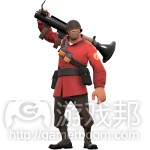
soldier(from gamedesignideas.com)
士兵:擅于攻击上方的目标,特别是那些难以触及的目标。在中距离进攻(即位于开放领域并面对着敌人的退出点)时,他们总能发挥出最强大的攻击力。但是在近距离范围或远 距离范围(游戏邦注:即在一个没有任何障碍的开放领域与敌人进行一对一较量时)时,他们的攻击力就会变得较弱。当医师隐藏在士兵周围时将对敌人造成致命的伤害。(环境= 面对敌人的退出点的开放领域,或者是在高地)
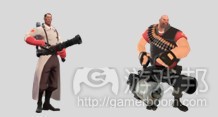
Medic & heavy(from gamedesignideas)
医师/保镖:擅于通过隐藏而近距离杀死敌人,同时也能够治疗保镖。是狙击兵和火箭的主要目标,并且因为速度较慢所以很难躲避各种攻击。因为总能够吸引间谍的注意,所以在 一些潜行区域非常不利。而比起攻击,保镖更擅于防守(因为移动性较不足)。(环境=医师的保护区靠近敌人所在领域)
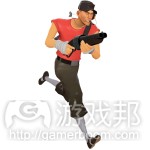
scout(from gamedesignideas)
侦查员:当他们在空中巡视敌人时擅于采取侧面攻击和快速捕获方式——这也能够帮助他们快速攻击与撤退。同时侦查员还擅于在全方位领域行动,因为在此他们总是能够快速追 上敌人。但如果他们必须在普通路线上执行任务,或被敌人保镖和喷火兵所包围时,其优势便不复存在。(环境:能够在各种不同的高度平台上自由行动)
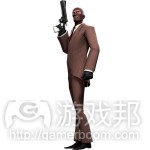
spy(from gamedesignideas)
间谍:通常都因此在开放领域的角落或间隙中。擅于深入敌后,或面对一个单独的炮塔。但是如果面前出现2个以上的炮塔,或者不存在隐蔽处的开放领域,他们也就没辙了。(环 境:拥有许多可躲藏空间的开放领域)
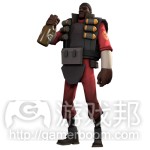
demoman(from gamedesignideas)
爆破兵:擅于在出口/入口处设置陷阱杀死单位。当他们成功躲避敌人并获得分数后,陷阱便能派上用场。除此之外还擅于将手榴弹投进窗户里或防御处的角落,从而成功防御敌人 的进攻。但是在开放领域,爆破兵便不是狙击兵的对手,并不能像在近距离进攻,或像侦查员那样击退单位。

sniper(from gamedesignideas)
狙击兵:总是隐藏在窗户或障碍后面而面向更广泛领域或远处的敌人出口。但是狙击兵不善于近距离战斗。(环境:带有窗户的房子,并且能够看到开放领域)

engineer(from gamedesignideas)
技师/哨兵:为了躲避手榴弹而隐藏在道路的90度角方向中。但是如果在没有弯道的开放领域或狭窄的隧道内,他们的行踪便会被藏在房间里的间谍所捕获。(环境:可防御的90度 角弯道内)
现在我们便清楚每种类型的角色所适合的环境。我们同样也会使用这些分类去增强或削弱攻击者或防御者的位置(即当我们想要优化叙述层面时)。
综述
我们的叙述将被用于单一的《TF2》关卡vs.包含相关关卡的地图(就像在最初的“淘金热”地图那样能让玩家循环通过)。每个转折点都将标记一个“检查点”。每个检查点将在 旅程初始时告诉他们新阶段的开始,因为我们的叙述转折点是等间隔的,所以很容易将其均衡地用于检查点中。除此之外,阶段一(背景)和阶段六(结果)将分别发生在友好的 一方(攻击者)和敌对一方(防御者)基础上,并且游戏规则也明确定义了这一点,所以我们只要遵循一些简单的实践便可,而无需花太多时间为它们设计关卡。以下我将分别描 述各个叙述阶段。
阶段1:背景
这时候攻击者还未开始战斗。他们能够选择类别,加载弹药,并了解场地等等,就好像英雄的日常生活。唯一需要记住的规则便是为攻击者提供多个出口,帮助不同类别的攻击者 进行快速分组。就像在我们的例子中,攻击者便拥有3个出口。主要出口(B)便很宽广,不存在防御物——对于驾驭重型车辆的攻击者来说这也是最近的出口。而出口(A)设有突 出物能够掩护攻击者顺利离开。出口(C)是一个受保护的出口,远离可能出现在出口(A)后面的哨兵。而(D)出口将引导着攻击者前往瞭望塔,让他们能够透过窗户观察狙击手 的位置。但是当(D)出口的大门敞开时,敌方士兵将很容易进入其中。
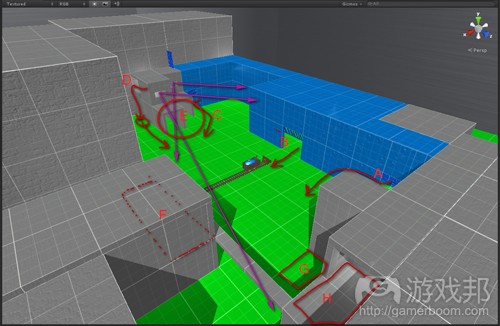
setup(from gamedesignideas)
在倒计时后,当大门敞开时转折点便会出现,就好似英雄的生活突然发生改变,而战斗也紧接着爆发了。
阶段2:新形势
当玩家进入一个新形势时,我们想要创造敌人与环境的互动。这一阶段将为之后的几幕场景确定基调。为了让攻击者能在这一领域中探索,我们需要创造一些隐蔽处让敌人能够躲 藏——但是我们不能让敌人完全控制整片领域。所以我们最终决定让敌人从(E)点前进到(H)点,因为这是最佳开火和伏击位置。这些点是专门用于引诱敌人,并且这里已经埋 伏了哨兵,但是攻击者也很容易征服这些敌人——因为它们刚好是面向于攻击者的射击线上。就像我们所看到的,攻击者可以从(A)点看到所有敌人的设置点。
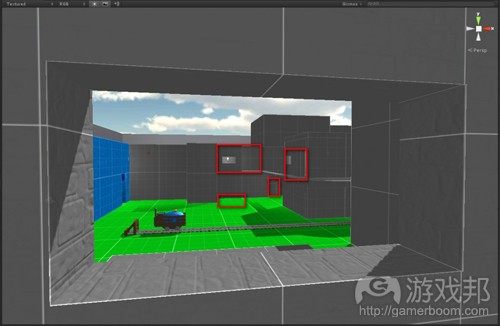
new situation (from gamedesignideas)
因为新形势是很好理解且很容易克服的挑战,因此我们拥有一个直线领域,并且攻击者可以在此轻松穿越至第一个检查点(=转折点),这便是所谓的“计划变更”。
“计划变更”转折点便是英雄做出选择或受驱动而转向可行目标的时刻。因此我们可以在此做出首个关卡决策,所以现在形势将从有趣的阶段2转向充满挑战且需要做出艰难决策的 阶段3。
阶段3:前进
这一阶段是关于起起落落。我们的英雄遭遇了挑战,他们正面临着最激烈的时刻。在面对新形势的冲击后,他们为自己的未来制定了计划,并开始朝着这一计划前进。为了推动玩 家去制定计划,我们需要提供给他们一些重要的选择。
以下是我们的做法:
*路径的选择:攻击者将选择是否待在主线上,清除建筑(T1)或移到建筑(T2)。如果他们在(T2)便能够选择是否离开并进入隧道(B)或直接离开凸起的地道而转向(T2)的 左边位置上。
*职业的选择:该领域是为了转折点(游戏邦注:即标志着英雄前进道路上的起起落落),首次埋伏点(T1,T2以及角落)以及为敌人而设置的防御点所设计的。攻击者在此遇到他 们的首次挑战,并且如果他们是狙击手或保镖,便需要在此转换职业,因为他们的“视距”优势已不存在了。
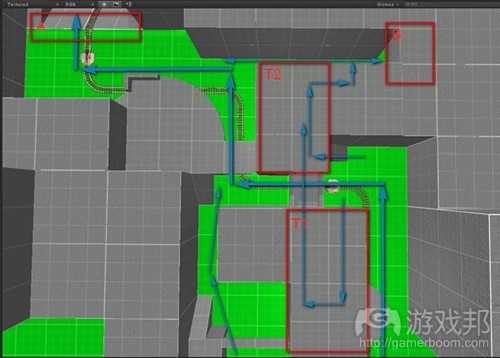
progress(from gamedesignideas.com)
我让敌人能够穿越隧道(B)快速到达冲突点(PoC),并在此铲平团队。这一设置能够让攻击团队意识到是时候制定防御计划了。
阶段3以“只能进不能退”的(A)点结束,我们希望能够让英雄(攻击者)感受到他们已经离开基地并将进入一个全新背景,他们需要在此做出艰难的决策。在战争电影中,英雄 将会与敌人同归于尽。而在好莱坞电影模式中,没有回头路便意味着必须做出两个完全不同的决定(游戏邦注:如射击罪犯或拨打911,迎面扑向敌人或逃走,对爱人撒谎或保持忠 诚)。为了创造这种差别,我将发生地点从一栋建筑转向阶段2中发生战斗的建筑,再转向另一个环境,让玩家可以选择是穿越隧道(B)而攻击敌人还是通过斜坡(A)而冲向狙击 兵。每个玩家都必须在此做出选择,并且他们的选择都具有很大区别,如作为待在广泛领域的英雄vs.待在黑暗隧道中的阴谋者。
阶段4:复杂化
除了改变发生地点,无掩蔽的斜坡和领域将会让攻击者有种“哦,天哪!”的感觉。阶段4将突出孤注一掷的战斗类型。
如果玩家选择斜坡,他们的行踪将完全暴露在狙击兵面前。如果他设法到达隧道(E)下方,他将遭遇敌人的埋伏攻击,在此期间敌人将从(G)下方跳出,狙击兵也将通过窗户去 射击攻击者的同伴。

complication 2(from gamedesignideas)
就像你所看到的,狙击兵将瞄准斜坡(A)与这条路线沿途的对象。在第一次测试中,我发现攻击者很难在此进行防御,所以我决定添加障碍物让他们能够在此隐藏。线圈也意味着 能够让玩家产生“哦,天哪”的感觉的区域。
另一方面,如果攻击者选择隧道,即从(A)到(B),他们必须克服这里存在的一大劣势,即一出去就会遇上敌人的枪口,并且可防御的位置靠近防御者的基地。这两种情况都创 造出了“机不可失”的形势。
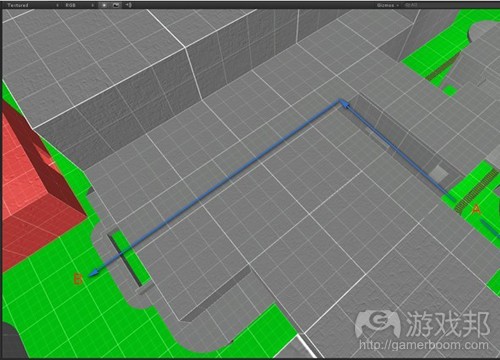
complication 3(from gamedesignideas)
这一幕结束于转折点4,即“主要的退步”。这一幕的标志性路径便是向上引导的斜坡,即敌人位于更高的位置,能够从侧面进攻英雄。对于那些能够离开隧道并朝着敌人基地前进 的人来说,他们前方的建筑物便是最难克服的挑战。就像好莱坞电影所做的那样,我也需要在此添加一些希望,这也是我为何会将狙击兵地道设置在开放领域前面的主要原因。
阶段5:最后出击
最能代表最后出击的便是桥,因此我便在这一阶段设置了一座桥。我同样也喜欢多层次的战斗战术,让两边的玩家能够通向水里,桥上,更高的建筑以及阳台。在这一幕,敌人非 常接近于自己的基地,并且我唯一能够带给攻击者宽慰的便是桥上的防御物(B)与(C),实际上他们已经穿越隧道,并得到桥后面的高塔掩护。而水能够缓解那些被喷火兵烧杀 的角色的伤痛,我们同样也需要设置斜坡让攻击者能够离开桥而获得第二次机会。
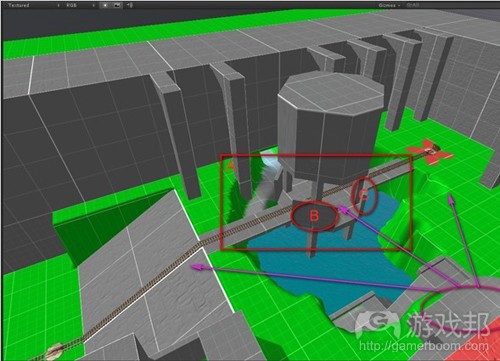
the final push(from gamedesignideas)
在下图我们可以看到桥的起点(A)是位于敌人基地的视线内;而隧道出口(B)则是源自狙击兵的地道,如此便能让攻击者在此对那些离开基地的敌人发起攻击;斜坡(C)将连接 着隧道与高塔,提供给攻击者掩蔽物,水(D)是在桥下。
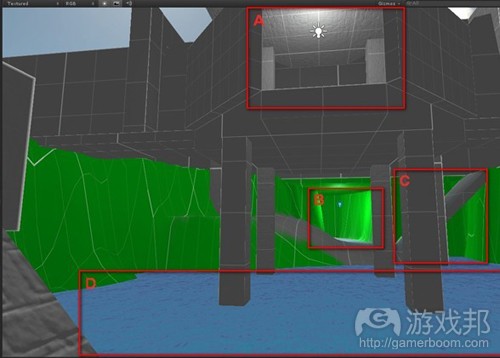
the final push 2(from gamedesignideas)
如果主要攻击者决定穿越隧道而发出最后一击(能让他们快速进入最后的PoC),他们就需要控制(B),(C)和(D)点,并让驱车的伙伴能够爬上桥。
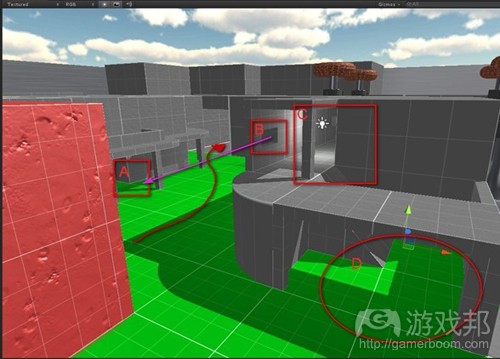
the final push 3(from gamedesignideas)
这一阶段是在转折点5“高潮”结束,即靠近我们叙述的结尾。这时候敌人拥有所有优势,而攻击者将做出各种牺牲去击退敌人。而当攻击者顺利过桥后,我们便来到了阶段6。
阶段6:结果
在桥的中间点,攻击者需要一些掩护,并且他们离最后的检查点只有几步之遥了。我尽量确保这一距离较短,从而不会夺去他们在中间点战斗的光彩。如果攻击者能够成功走到最 后检查点,他们便能够炸毁后退的敌人并获得最后的胜利。
最后我还想提醒你们的是,与攻击者基地一样,防御者的基地也需要多重出口,而因为防御者基地非常靠近PoC,所以我让攻击者能够在桥的中间点(B)看到领域(D)和(C), 并通过主要保护出口(A)快速进入这两个领域。

aftermath(from gamedesignideas)
结论
正如你们所看到的,我便是通过使用容易理解的象征物(游戏邦注:弯曲的路径,暴露的领域,上下斜坡,桥,秘密隧道等),控制攻击者团队的挑战/缓解关卡,在特定点上提供 各种选择类型,并控制攻击者经历每个关卡与到达转折点的时间而呈现出了好莱坞式电影所具备的6个阶段叙述过程。
相关拓展:篇目1,篇目2(本文由游戏邦编译,转载请注明来源,或咨询微信zhengjintiao)
The Hollywood Screenplay Approach to Designing Game Levels: Part I
by Babak Kaveh
Almost all Hollywood movies released in the past forty years are based on screenplays that use a singular structure. This article will introduce the Hollywood screenplay formula, and examine waysto apply that same structure to gameplay design. We won’t be using the screenplay structure for a game story, rather, we will attempt to create a narrative using only game mechanics, and more specifically, applying the formula to the design of levels and play sessions in different game genres.
Most Hollywood movies start out by introducing the viewers to the hero and his current situation. Then an event happens that upsets the current state of affairs, and the antagonist is introduced.
There is an initial challenge that the hero overcomes, thus proving himself to the audience. Somewhere in the middle of the movie, we get to the point where the hero must make a momentous decision and the viewer gets to understand the final goal he must achieve in the movie – this is the point of no return. From there on the hero has an uphill battle, which culminates in one last big push, and if the hero is able to overcome that last challenge, you get to see how it has affected their life and the life of others – they reap the rewards, and if there is to be a sequel, we also get a glimpse of another challenge on the horizon. Of course there are small variations on this theme, e.g. we can have multiple heroes, and the antagonist might not be a human, but a force of nature, or an angst the hero must overcome. Michael Hauge’s has an excellent summary of the separate stages of this formula.
It is surprisingly easy to come up with alternate narrative structures, and yet very few screenplays outside this rather strict structure have succeeded, at least in Hollywood; it is a winning formula, and movie producers know it. That said, what can we game designers learn here? A whole lot: the formula will teach you how to make each game level a narrative that the player is a part of – a mini movie that your audience will enjoy and remember playing, and this gameplay narrative will resonate with a majority of your audience, based on what they have come to understand and accept in movies.
I am aware that in an environment where some designers still think narrative is unnecessary and evil, claiming that giving your gameplay a narrative structure will sound like a waste of time, but bear with me as I apply the Hollywood formula to the design of a variety of game levels, and you will see not only will it make the level more consistent, it is actually a great brainstorming tool.
In the next installment (to follow shortly) I will also try to explain how some of the most successful Payload levels (pl_badwater and pl_goldrush) follow this formula very closely, and walk you through a new TF2 Payload level design from beginning to end.
An Overview of the Hollywood Screenplay Structure
Following is a summary of Michael Hauge’s description of the Hollywood screenplay structure and example screenshots from the recent movie “Battleship”.
Our hero is an impulsive, undisciplined womanizer
Stage 1 – The setup
This is the beginning of a narrativve where you are introduced to the hero(s), and possibly his companion(s) everyday life. This is where you try to make them likable and interesting to the audience. The setup normally takes up the first 10% of the duration of the movie.
After his run-in with the police, our hero’s brother forces him to join the marines in the hopes that he will get his life togetherTurning point 1 – The opportunity (@ 10%)
This is where the hero is presented with a new opportunity/threat that they cannot refuse/escape (internally or because of external forces). The opportunity makes the hero leave behind the status quo and start on a journey , although ogically at this point the hero could presumably go back to the status quo, but we know that won’t happen.
Our hero is an officer in the Navy, and in a relationship – still undisciplined but in a whole new world/way
Stage 2 – The New Situation
After having responded to the opportunity or initial threat, now the hero gets acclimatized to the new life he will be leading. This is where hero’s hear about their nemesis for the first time or get to learn how to use guns for the first time. This is the initial discovery phase for the hero which leads to him coming up with a plan to reach the goal set forth by the opportunity but in the background we want to show the audience that conflict is building around the her. This stage takes up another 15% of the total movie duration.
“Getting the girl” loses in importance when aliens crash-land on the Earth!
Turning point 2 – The change of plans (@ 25%)
This is where something happens that causes the hero to change his plans. It takes the hero from the new world that the opportunity defined, to a whole new level, where he will define the final visible goal that he will achieve in the movie. The guy might have found the right girl and now he wants to get her, or maybe the ex mercenary decides to protect the people he was sent to kill. The visible goal is what the “audience is rooting for your hero to achieve by the end of the film.”
Hhuman ships are in a stand-off with the alien spaceships
Stage 3 – Progress
Now the hero is in the thick of things and starts to make progress towards the visible goal. It is where the hero goes from having been caught off-guard by the change of plans, to where they align all their powers and allies to reach their goal. Conflict is still building at this stage but it is nothing the hero cannot overcome. This takes up another 25% of the total movie duration.
Our hero’s brother is killed by aliens and his ship is destroyed. There is no going back now, they must be defeated (which is the visible goal of the movie)
Turning point 3 – The Point of No Return (@ 50%)
Here an event happens, or the situation evolves in a way that will limit the hero in going back from his plans. This is the event or moment that defines the hero’s path all the way to the end of the movie. Bridges are burned and there is no going back and the audience knows it.
Close encounters of the third kind, and hand to hand combat with aliens, but our hero is doing fending off every offensive
Stage 4 – Complications
During this stage conflict builds to a point where the hero simply cannot risk loosing. It becomes all or nothing. The hero fight hard, but then just before the hero seems to score a major success the major setback happens. This stage which will also take up about 25% of the total movie duration.
The tides have turned – Alien “wheel-whizzer-thingies” shred the hero’s ship into slivers
Turning point 4 – The major setback (@ 75%)
This is the disastrous event that causes the hero to seemingly lose any chance of achieving the visible goal. He is captured, or important allies or companions leave him or die, or maybe there is a major betrayal. Things start to look real dark at this point.
The survivors regroup on the Mighty Mo and get her ready for a final grand battle
Stage 5 – The final push
Now the hero has to gather all of his energy and resources one last time to overcome the challenge. He is real close to the finishing line – the pace is furious at this point and it’s all or nothing. This stage should take up another 15-24% of the total movie duration.
She fights valiantly despite her age, and the alien mothership is destroyed and their communication scheme neutralized
Turning point 5 – The climax (@90~99%)
This is where the hero faces the final challenge, determines his own fate and the visible goal of the story gets resolved. It is where the hero fights and kills the end-boss or solves the final riddle of a crime or dies trying. It is also what the audience will probably be remembering about the movie later on.
Hero gets medal – hero gets girl – hero gets admiral’s recognition and respect – The End.
Stage 6 – The aftermath
This is where the audience winds down and gets to see the result of the events in the climax. The hero gets married or buried or gets to live happily thereafter! This stages takes up a minimal amount of time of the total movie duration, typically just a few minutes.
Applying the Structure to Game Level Design
Let us plot hero challenge (or audience tension) vs. time based on the timing of the stages and events from the Hollywood formula described above:
This is very similar to the punctuated sawtooth plot of challenge over time many game developers have proposed over the years:
Challenge vs Time in RPG games taken from an article by Thomas DuPont
Now it’s time to discuss how we can lay out our level to conform to the successful formula we explained.
Stage 1 – The setup
Although many designers leave this stage out, falsely assuming that video game players want to jump straight into the action, adding some sort of introduction into a level gives players to find their bearings and get to know their avatar, the controls and movement, as well as a sense of security before making their own conscious decision to enter the fray. This is a subtle point, but players will not appreciate it when you throw them into the arena without allowing them to make the choice. Now, you may argue that the moment the player started the game, they already made the decision to face up to the challenge, but don’t forget that allowing players choice is what games are all about, and the more meaningful choices you allow the player to make, the better your level will work.
It is very easy to add a Setup to your level. Platformers and shoot ‘em ups do this by adding a section in the beginning of the level where enemies don’t exist. TF2 does it by allowing players 60 seconds to charge up their Ubers and pick their classes before the gates open, and Fallout: New Vegas has an entire starter area where there are absolutely no enemies and where you get introduced to the backstory. WoW, similarly provides safe starter areas for each race. There are three important points in setting up the “the Setup” area:
1. It has to be safe
2. It has to teach the player about the game environment and the avatar’s back-story
3. The player needs to be able to exit the area within 10% of the duration of a play session or the level play-time, whichever is smallerPoint 1 and 2 are straightforward, but I will explain point 3. Take a game like Fallout: New Vegas. Let us make an educated guess that the average playing session for the game/level will be around 1-2 hours. This means that the player needs to be able to get all the startup resources he needs to enter the badlands within 6-12 minutes of starting the game. Assuming the same for WoW, the player would need to be able to get a valuable kill within 6-12 minutes of starting in their safe zone. For a platformer where a level might last only a couple of minutes, the first kill or challenge should be available within 10 seconds.
There are games out there that don’t follow this rule of course, and they lose something because of that – BIT.TRIP Runner being a notable one where starting a new level it is very easy to feel pressured and helpless and it takes a few seconds and successful jumps just for that negative feeling to dissipate. BIT.TRIP Runner also never gives you a chance to understand the elements in the gameplay and what each do before you run into them and die and there are barely 3 seconds to check out the level before your first jump. Bad BIT.TRIP!
Turning point 1 – The opportunity (@ 10%)
This is where the player meets his first challenge. It is not the challenge that will send him on his quest to save the universe – that will come later – rather, it should take the player out from his safe environment, into a new area or situation where they need to start acting, and actively exploring new options. That’s where most games go wrong. In their hurry to provide meaning to their story, and gameplay challenge to the player, they send the hero off on a secret mission to save the world from a soviet nuke.
Bypassing the first turning point and going straight to the point of no return will take valuable time away from the designers which can be spent on exposing the inner life of the hero and his allies (NPCs) and give them a second and third dimension. It also removes the player from the plot in that it doesn’t give them enough reason to care for the universe or NPCs or other online players that they are supposed to save.
There are a number of ways to create a turning point and they all involve an event that is forced on the player, allowing them to accept the initial challenge, or stay in their safe zone. In TF2 e.g. when the gates first open, the player can decide to stay in the safety of the base, or move out after all the ubercharges are spent and the initial frenzy is over. Another way to give the player the best weapon or vehicle in the game, and teleport them into their future self where they will get a taste of being cool without any risk of loosing, although this method does risk creating frustration in players once they
are ripped out of the fantasy and given a rusty knife to fend for themselves. Oblivion had a nice turning point where the player went from being a prisoner to having the honor of protecting the king.
Stage 2 – The New Situation
This is the stage where a fighter starts fighting – a spy, backstabbing. Note that at this point we are NOT sending the player on his final goal. E.g. if the final goal is to capture a certain control point, the turning point will not allow them to do that yet. There should be no chance of the heroes (in TF2 this is the attacking team) wining the game at this stage. This can be done by making the initial base breakout hard for faster/sneakier classes e.g, or simply making everyone have to fight their way through to a point where they can start their actual mission – They still get to kill enemies, but they
cannot rush to the control point – not yet!Turning point 2 – The change of plans (@ 25%)
After the initial combat, or introduction to the new life the hero will be leading, we start them on a path towards their goal. In TF2 this means the attacking team gets to start pushing the payload e.g. or move forward towards the control points. We facilitate this by selectively weakening the position of the enemy (defenders in TF2) by making them walk for a long time before getting to their defensive position, or by delaying their respawn a bit longer, or by taking away some of the beneficial potential fighting positions. In an MMO, e.g. this would be the stage where the hero receives a great ability that allows him to do the first part of the story quest at a fast pace. In a platformer, this might be the point where you introduce the hero to his goal of saving a princess, and giving him a first glimpse of said sexy lady!
Stage 3 – Progress
At this point it should be easy going for the heroes. The playing field is tilted in their favor. This can be done, and should be done even in games where humans play against humans. In TF2 this is the part of the level where the attacking team gets most of the advantageous positions . This might mean opening an access route (backdoor) to the first control point, or creating an easily defensible path that the payload cart can be pushed through. Make this stage last for 25% of the game time or play session duration, and let the heroes of the game feel awesome for the time eing.
Turning point 3 – The Point of No Return (@ 50%)
Contrary to sports, in Hollywood, half-time is not a time of respite and rest – It is the point where something happens that destroys any chance of the hero ever going back to his original life or even new situation. It is the point where he decides that he must push forward.
In the context of level design this can mean many things:
· For a platformer: It will now be impossible to traverse levels without the newly gained awesome double-jump or jetpack. It is also impossible to kill many enemies without your thunder-stomp! And if you slow down or fail, the princess will be killed, slowly – make sure your player knows that!
· For an MMO/RPG, this is where the world changes in response to the hero’s actions. E.g. A particular dragon might have risen who needs to be defeated before he reaches the birthplace of the hero.
· For a Multiplayer shooter like TF2/BF3 this is the point where the attacking team gains control of a forward spawning/landing position that is so good that the original starting base is made obsolete, or maybe even locked out.
Stage 4 – Complications
In stage 3, the hero got all the benefits. Now the tide will start to turn and the hero and his enemies will be balanced out. This means that both teams have an equal distance to go to reach the battle hotspot e.g. or the hero simply hits the limits of his awesome power because enemy NPCs are rising in level.
We can also artificially introduce extra challenges by adding extra conflict points around the map or within the story – maybe the hero has to sacrifice an ally to get through, or there might be traps that will leave the hero with very little HP before he manages to come out the other end. Betrayals are also a commonly used story element here, and so are time limits. This is the part of the TF2 level where enemy spies run amok, and this naturally brings about the next turning point as they sap forward attacker teleports and defensive positions.
Turning point 4 – The major setback (@ 75%)
The major setback is the darkest hour of the hero’s existence and unlike most other stages that can be achieved by tweaking gameplay/level elements requires a certain degree of engineering to make it work. After all the complications in the previous stage, we want the hero to be in a very weak position at least for a short while. Here are some ways to do this:
In an RPG: Endgame boss appears, and as the player is fighting him casts tons of debuffs on him that will last for quiet a while after the boss himself has left the arena.
In a platformer: reduce the number of health/ammo powerups. Now the hero needs to start counting bullets and health points.
In a strategy game: the player is flanked on three sides by the enemy, or even better, after his allies left him or dies in the previous stage, he is now stuck with a tiny defensive force and has to fight his way out through a painful gauntlet. We want the hero to be standing alone against the horde at the end of this stage.
In multiplayer shooters: give the defenders a great ambush chance, or a great sniper nest. Those two particular obstacles are a serious blow to the attacker (hero) morale and can definitely elicit the feeling of going through a major setback. However, make sure that those particular ambush/sniper nests are also possible to overcome. Do not place them in spots where enemies can easily get to them over and over, or you will have inadvertently created the climax before
the players actually reach their goal.
In order for a climax to work best, we want all elements (closing in on the goal, final push, lots of conflict, balanced fight) to come together at the same time.
Stage 5 – The final push
In stage 3, the hero had all the benefits. In stage 4 the two sides were balanced out. Now it is time to give the antagonist(s) (in TF2, the defenders) the teeth. Provide the enemy with great sniper position, and good cover. In TF2 the fact that the conflict points are now closer to the defender base provides a natural benefit to the defenders. In all other games, this is the time where the player constantly has to switch weapons because they run out of ammo, and has to use up a lot of potions or they simply won’t function. The final push is an intense and uphill battle (literally making this an uphill battle is a great way to use the symbology in game where having higher ground gives the enemy benefits, e.g. in most shooters or strategy games).
During this stage, the hero needs to be able to see the goal (the last control point, or the last waypoint on a TF2 payload map e.g.). He needs to be able to get to the conflict point really fast (in Battlefield games, there would be multiple fast vehicles at the control point right before the last one) and the final battle area needs to be very concentrated. Do not create wide open areas or trenches for this stage. Make the conflict direct. Also don’t forget to give the enemy lots of benefits that will really hurt the hero, and if your game mechanics allow for time-limits use them in the nastiest possible way at the end of this stage. This is the only part of the level where the level designer can go all-out sadistic on the player, and as long as there is some chance of the player being able to punch through, they will not be whining too much (well, they will, but they will also see the point and enjoy the fast pace).
I have pointed at some of the elements needed to create a final push stage in your game. How can we implement those in different genres?
In a strategy game: After the hero got through the major setback alone, he is now replenished with all possible units in the game, and the enemy is overrunning the planet with all of their forces.
The final battle is set in an hourglass level with huge waves of enemies eating away at the players defenses in a concentrated area. As we near the climax, the waves get larger, and the player’s army keeps pace. At one point the fighting gets so furious that the player starts to feel the pressure of micromanaging units. There is also a timer before the enemy is able to produce their nuke unit If the player cannot destroy their factory, and the enemy is starting to use larger and larger, and maybe even hitherto unseen units.
In a platformer: in this level platforms fall as you walk over them…you need to be fast and constantly move forward, and the enemies are relentless… sometimes it becomes more viable to just dodge their bullets and run instead of trying to kill them. There is only one visible and viable path, and very little time to choose anyways. No puzzles here….just relentless fighting and moving forward. Maybe the world behind you is crumbling at a constant speed – maybe you can hear the screams of your avatar’s “romantic interest” as she is being assimilated by Cthulhu himself ….
In an RPG: you have discovered the dungeon where the final boss/enemy resides, but his minions are not willing to serve up their master. Wave after wave of progressively stronger enemies come at you from the front, and from behind, and there is no time to explore, or maybe even open those loot chests. Monsters spawn so fast that going back and resting is not an option. Then there are the vilest minibosses in the game that you have to go through, before reaching the
chamber of Jronichiloctiel the Soul crusher!
In a multiplayer shooter: This is the fight for the final control point, or the capture of the enemy base. Allow the attackers to spawn nearby, or get there fast. Give them all the fancy weapons they want, but give the defenders an awesome position (e.g. let them have higher ground, or force the attackers through an hourglass level – you should of course never have only one path to go through, but you can always have one seemingly easy way to the enemy base and
multiple really dangerous ones ![]() ). For this to work, you need to give attackers/heroes an awesome forward staging area (i.e. if your game/spawn mechanics allow for this) and let the defenders have access to all sorts of defensive turrets, etc.
). For this to work, you need to give attackers/heroes an awesome forward staging area (i.e. if your game/spawn mechanics allow for this) and let the defenders have access to all sorts of defensive turrets, etc.
Turning point 5 – The climax (@90~99%)
The climax is the hero’s chance to overcome that one last giant obstacle to reaching his visible goal. In a game level this is the final boss battle, the capturing of the enemy base, or killing the last enemy standing. Here are some point to remember about the climax:
1. Don’t reduce tension artificially right before the climax. This is a stupid gimmick akin to screaming at your audience “Haha got you there!” Instead let it arise naturally from the already rising tension in the “final push”.
2. In order to overcome the final enemy, the player should use a lot, if not all of his skill/knowledge gained in the latter parts of the game. This is not the time to introduce new mechanics – it’s the time to demand the most of players based on already seen mechanics. For example, if success in your game was based on constant movement and quickly dodging enemy attacks, don’t put the player in a static turret that shoots at some giant end-boss!
3. It must resolve the hero’s quest. There is no more challenge after the climax whatsoever. After the climax it’s done! There should be no cleaning up to do. If the boss spawned adds during combat, once he is gone, the adds should blow up or something. Don’t distract the player from their huge achievement. Let them fully enjoy it. And then let them get their reward before the sweat on their brows dries!
In terms of level design, the climax is a natural extension of the final push, with the addition of one more element. This could be a final bomb that needs to be installed at the gates of the enemy base, or an end-boss, etc. Once the climax point is reached, it is not wise to suddenly negate all the prior challenges the hero was facing; no calm before the final storm here.
If you have a fighting game the arena where the final climax takes place normally has a central area where it all happens. It has entry points all around the arena, and players should be given no reason whatsoever to fight it out outside of this arena. Lock any backdoors that would distract from the final battle, and don’t let the defenders sneak pass attackers and backstab them. Also, avoid having any complex or smart enemies (except for the final boss) at this stage: having to think reduces pace, and new enemy behavior slows down flow – we don’t want any of that.
If you are making a puzzle or adventure game, this is where you repair that awesome giant mechanical contraption that will align Gaia’s energy with the center of the galaxy and save the world!
In an MMORPG, this would be the final boss in the story missions that needs to be beaten, or in case of dungeons it would be the end-boss battle.
In all of these cases make sure that the visuals tell the player that they have reached the end of the level before they enter the final battle (e.g. circular arena with tons of opening and no exit behind the boss), and make sure the final boss/challenge tests the players in multiple ways (speed, coordination, smarts, gear, armor, sensible tactics, etc.)
Stage 6 – The aftermath
After all the madness in the final push and the climax, and after the final goal has be resolved (hopefully in a final and definite way) it is time for the heroes to have a rest and enjoy their reward. A few points that might need repeating here are:
1. Make sure the player knows that he has won. Enemies should not be shooting at you anymore, and players should not find ANY challenges in their environment after the climax.
2. Give the player time and space to enjoy his reward. In TF2, successful attackers get to chase down and crit cowering defenders. In RPG’s players get access to all the treasures strewn about in the Boss’s chamber. In MMORPG’s this is when loots gets divided up. Many games simply announce that you won, and load the next level. Sometimes you don’t even get enough time to check out the leaderboards: this is bad design and rushing the player who gets no sense of closure and reward.
3. Avoid half-assed aftermaths. Let the player utterly defeat the antagonist or marry the girl in a happy ending or allow the Hero’s beloved one to die in a sad ending (instead of them being hurt e.g. or leaving the hero). Don’t let the nemesis get away, at least put him in prison, or magically lock him in a rock for good. Players hate to see that after all their trouble nothing happens to the baddies. Leave a clue for the sequel if you want to, but also give a good sense of closure to players.
There aren’t many level design tips for the aftermath except that:
a) Do not forego this stage and rush your player out the door into the next adventure.
b) Give players ample reward and time/space to enjoy that reward. Praise them, and show them how well they have done. If the player saved the princess have the princess kiss them, or have a marriage ceremony or something , or if they were supposed to destroy the enemy base, show them in gory detail how they bombed and burned their enemies and how all the structures came down in beautiful Destruction2 ?.
c) If this was a mini-story (like a dungeon in a larger MMORPG) don’t make players work in the aftermath of their success, e.g. teleport them out of the dungeon instead of making them walk out.
Give them a magical glow and let them feel like kings for a while.
In the next installment of this article, I will create a TF2 Payload map that follows the Hollywood formula, and I am sure you will start to see parallels with existing popular payload maps. Go ahead and play around in the map a bit before you read the full details of the design. I would also love to hear from you about other ways to make the Hollywood formula work in different games, and if you are a designer, let us know if you have ever consciously followed this or a similar flow design formula in your own level designs.
In part I of this article I discussed the six-stage Hollywood storytelling formula and how it can be applied to level design. I also promised to show you a practical example in the form of a TF2 Level. If you want to play the level before ccompanying me through the design process go ahead and have a look.
If you can’t play the level you might have to get the latest Unity 4 web player plugin for Mac or PC. You will need at least version 4.0.0f5.Zzzzz…
Glad to see you are back! Now the boring/educational part:
TF2 Class Rundown for Level Designers*
Before we start designing the map, we need to remember who we are designing it for, namely the player classes in TF2. Each of these classes has their strengths and weaknesses, and they all must be catered to both as attackers and defenders. Even though players do switch classes when they have to, they also have favorite classes that they play well (or think they play well) and a map that allows all classes to be utilized in interesting ways at different stages will be popular with players.
Here is a quick rundown of the classes in TF2 and how they affect the design of our level:
Pyro: excels at ambushing groups of enemies at close range and finding/killing spies in narrow tunnels and in closed to open area transitions. They are easily killed in wide open areas. (Element = Narrow Corridor/tunnel)
Soldier: excels when above target especially when hard-to reach or see perches are available. Most powerful at medium ranges and when standing in an open area that faces an enemy exit point. Is weak at close ranges or very long ranges and when fighting one on one in open areas without obstructions. When a medic can hide nearby the soldier can cause havoc on enemies with splash damage (Element = open area facing an enemy exit or when on high-ground)
Medic/heavy: excels in killing enemies at close range when medic can hide while healing heavy or if close to a cart and where the heavy faces a narrowly spaced group of enemies. Is a large target for snipers and rockets, and is slow so cannot really duck. Also draws spies like dung draws flies so is very weak in tight sneaky areas. Heavies are generally better for defense (due to low mobility) than attacks, unless they are ubercharged of course) (Enemy funnel next
to protected area for medic)
Scout: excels at flanking and fast surprise captures when aerial access exists to go around enemy defenses – this also enables them to do quick hit and runs. Scouts do well in multi-level areas and places where they can outrun enemies around corners. When they have to take the common routes or when enemy heavies and pyros are around scouts are easy canon-fodder. (Element: exploitable height-differences and bends that allow loss of LoS)
Spy: excel in open areas with nooks and crannies they can regenerate in. Excel at getting behind enemy lines or to where only one turret can stand. Very weak against two or more turrets, tight spaces, and open areas with no hidden nooks. (Element: areas with lots of rooms)
Demoman: excels at killing units at entrance/exits (especially exists) with sticky traps. Traps also come in handy when defending enemy gather points. Excels at lobbing grenades into windows or around corners of defensive positions which makes him excellent at defending choke points. Demos fail in wide open areas against sniping and are weak against fast units like scouts or at very close range. (Element: Mazes/Corridors/cave funnel exits)
Sniper: excels when hiding behind windows or obstructions, and facing a wide open area or an enemy exit at large ranges (Generally you should not give them LoS towards narrow exits). Spies are weak in close combat or when spies have alternate access to their perches. (Element: windowed rooms with good LoS on open area)
Engineer/sentry: Dominate area when hidden behind 90 degree angle in path and if defended against grenades. Defenseless in open areas or narrow tunnels when there is no bend or in areas that are easily accessible by spies (backdoors). (Element: defensible 90 degree bends)
Now that we know which elements each class excels at we will give them access to ample opportunities to use those elements. We will also use this knowledge to weaken or strengthen the positions of attackers or defenders when needed to drive our six-stage Hollywood inspired narrative.
Overview
Our narrative will be applied to a single TF2 level vs. a map consisting of related levels that players cycle through as in the original ”Goldrush” map. Each turning point will be marked by a “checkpoint”. Checkpoints provide a perfect symbol to signal to the players that a new stage in their journey has begun, and since our narrative turning points are evenly spaced, it is easy enough to adapt them to be equivalent to checkpoints. Additionally, Stage one and six which are the setup and the aftermath will happen inside the friendly (attacker) and enemy (defender) bases, respectively, and they are clearly defined by the game rules, so we will not spend too much time designing the level for them, other than following simple best-practices. So here is the breakdown into narrative stages
Stage 1 – The setup
Here the attackers haven’t started the fight yet. They are allowed to pick classes, load their ubercharges, overcharge, get acquainted, taunt, and generally be silly. This is the perfect analogue to the every-day life of a hero. The only rule to remember is to provide multiple exits for the attacker base that provide quick break-out opportunities for the different classes. In our case our attackers have three exits. The main exit (B) s wide and provides no protection – it is also the closest exit meant for heavies and ubercharged attackers. It is also the closest point to the cart. Exit (A) allows for support
classes to exit somewhat protected by the protrusion. Exit (C) provides a protected exit further away from the possible sentry gun that might be behind the protrusion at (A). There is also a protected exit that leads to the watchtower at D which also provides a good overview of the field to snipers via windows. Though enemy soldiers can rocket-jump into (D) they won’t stand much of a chance when the gates open.
Turning point 1 “the opportunity” happens when the gates open after the count-down. Again a perfect metaphor, as the life of our heros now suddenly changes and battle ensues.
Stage 2 – The New Situation
As soon as players break out into the new situation we want to create a complex interactions with enemies and the environment. This area will set the tone for the future stages. In order to allow attackers to explore the area above all we need nooks and crannies where enemies can hide – yet we cannot give the enemies full territorial control. To this end, we will give enemies points (E) through (H) which with seemingly good firing and ambush positions. These points are designed to tempt the enemy to set ambushes and sentries, and yet they are easy enough to overcome because they are open to attacker firing lines. As you can see, from Point (A) attackers will have a great view towards all enemy setup points.
The new situation is generally an understandable and easily overcome challenge, therefore we have a straight track out of the area, and it should be easy enough for the attackers to break through to the first checkpoint (= turning point) which is the “change of plans”.
The “change of plans” turning point is where the hero makes a choice or is driven to the visible goal of story. Therefore we place our first decision point of the level here and now things go from interesting and fun in stage 2 to challenging and requiring tough decision in stage 3.
Stage 3 – Progress
This stage is all about ups and downs. Our heroes are challenged, and they are in the thick of things. This is where, after the initial shock of the new situation, they create a plan for their future and start to work towards it. In order to force players to make a plan we need to provide them with important choices.
Here is how we do it:
Choice of path: Attackers get to choose if they will stay on the main track, clear out building (T1) or move on to building (T2). If they are in (T2) they can choose if they want to exit on the top and enter the tunnel (B) or exit right unto the raised gallery to the left of (T2).
Choice of class: the area is designed to be full of twists and turns (which symbolize the ups and downs of the hero’s progress), and for the first time “real” ambush points (T1 and T2 and around corners) and defendable sentry points for the enemy are introduced. This is where the attackers meet their first challenge and will be forced to switch classes if they were snipers or heavies, etc. as most of their Line of Sight benefits are lost.
I provided the enemy with a quick path to the point of conflict (PoC) through tunnel (B) to even out the teams at this point. This equality will give the attacker team a sense that they have now entered the stage where they need to start coming up with a plan.
Stage 3 ends with the “point of no return” (A) above – we want to make the heroes (attackers) feel that they have left their base behind and are now entering a whole new setting – where they are required to make painful decisions. In a war movie, this would be where the heroes chopper crashes behind enemy lines. In the Hollywood formula the point of no return always poses a painful decision between two contrasting things (e.g. shoot the criminal or call 911, Charge head-on or escape, cheat on a loved one or stay loyal). In order to create this stark contrast I implemented a huge change of venue from the building to building combat in Stage 2 to an environment that gives players a choice of backstabbing the enemy (via tunnel (B) above or charging ahead into sniper territory via ramp (A) above. Each player has to make a choice here and the difference between the choices is a big as it gets, i.e. being a hero in a wide open area vs. a ackstabber in a dark tunnel.
Stage 4 – Complications
Besides providing a change of venue, the exposed ramp and area beyond creates a delightful sense of “Oh crap!” in the attackers. Stage 4 forces an all-or- nothing combat style.
If the player has taken the ramp he will be fully exposed to sniper fire from the end of the field. If he manages to get to the entrance to the tunnel at (E) below he will have to face enemy ambushes to fight his way into the tunnel and to silence the snipers, and during all that time his team mates pushing the cart will be completely exposed to enemies jumping down from (G) below, and snipers through the windows.
As you can see in the image above the snipers in the sniper gallery could be duck-hunting on the ramp (A) and along the track. In my first tests this was just too easy to defend– so I added obstructions (the Tesla coils) where attackers can hide, even if for a short while before pushing the cart forwards. The coils are also meant to add to the “Oh crap!” feeling!
On the other hand if the attackers had taken the tunnel (from (A) to (B) below) they would have had to overcome an extreme disadvantage at the tunnel exit when they faced the enemy machicolations first, and an easily defendable position close to the defender base thereafter. Both cases offer a “now or never” situation.
This stage ends in turning point 4, “the major setback”. For the cart pushers this is symbolized by a ramp that leads upwards and where the enemy has the higher ground and a path to flank them (by jumping down the ledge to the open area. For anyone being able to exit the sneaky tunnels towards the enemy base, the building in front of them will be very hard to surmount. I did need to inject a glimmer of hope as in any good Hollywood movie, and that’s why I connected the sniper gallery in front of the open area via a secret tunnel to an area close to the enemy base.
Stage 5 – The final push
Nothing symbolizes a final push as a bridge does; hence, I went all-out Jungian and jammed a bridge in there. I also liked the multi-level combat tactics that the exit into the water, the bridge, and the higher up buildings and balconies surrounding it allow players on both sides. Here the enemy is very close to his base, and the only comfort, albeit a small one, I could offer the attackers was the shielding (B) and (C) on the bridge and the fact that they have access through the tunnel and further protection from the high columns behind the bridge. The water needs to be there to provide people burned by pyros with some relief and we needed the ramps so attackers blown off the bridge get a second chance.
In the image below you can see the bridge opening (A) which is totally in LoS from the enemy base, the tunnel exit (B) from the sniping gallery which will give attackers relief and a chance to attack the enemies exiting their base, the ramp (C) out of the tunnel that leads behind the large columns that offer cover to attackers, and water (D) under the bridge.
If the major attacker force decided to make the final push through the tunnel (which also provides them with a quick access to the final PoC, the will need to take control of points (B), (C) and (D) below ad give their cart-pushing buddies a chance to get on the bridge.
This stage ends in turning point 5 “the climax” which needs to be very close to the end of our narrative. It is where the enemy has all advantages and the attackers by extreme measures and personal sacrifice overcome the enemy. In our level this is the exposed mid-point of the bridge. Once attackers are past it, we get to stage 6.
Stage 6 – The aftermath
After the bridge mid-point the attackers get some cover, and from there it is only a few meters to the final checkpoint. I kept this distance really short, so that the battle for the mid-point is not overshadowed. If the attackers have gotten this far they get to enjoy the fruits of their labor by blasting away at cowering enemies!
Before I finish, I do want to remind you that just like the attacker base, the defender base needs multiple exits, and in this case, since the defender base is so close to the PoC, I also gave it good LoS over the bridge mid-point (B) and quick access to other areas (D) and (C) from their main protected exit (A) as you can see below.
Conclusion
As you see it is entirely possible to lay out the six stage narrative of Hollywood writers by using well-understood symbology (twisting alleys, exposed areas, down/up ramps, bridges, secret tunnels, etc.), controlling the level of challenge/relief for the attacker team, by allowing for multiple types of choices at specific points, and by controlling the duration it will take the attackers to go through each stage and reach the turning points. If you have more ideas on how to control and shape the narrative, without taking away control from the players, or a critique of how the level was lain out I would love to hear from you.








































